
Banksia dallanneyi, commonly known as couch honeypot, is a species of prostrate shrub that is endemic to Western Australia. It only has a short above-ground stem, pinnatipartite or pinnatisect leaves, between thirty and seventy variously coloured flowers and glabrous, egg-shaped fruit.

Eremophila brevifolia, also known as spotted eremophila, is a flowering plant in the figwort family, Scrophulariaceae and is endemic to the south-west of Western Australia. It is an erect, open, spindly shrub with sticky, short, serrated leaves and white to pink flowers and is only known from a few scattered populations.

Grevillea diversifolia, the variable-leaved grevillea, is a species of flowering plant in the family Proteaceae and is endemic to the south-west of Western Australia. It is an erect to prostrate shrub with simple or divided leaves and groups white to cream-coloured flowers with a dull red style.

Grevillea pulchella, commonly known as beautiful grevillea, is a species of flowering plant in the family Proteaceae and is endemic to the southwest of Western Australia. It is a spreading shrub usually with pinnatisect leaves, and cylindrical clusters of white to cream-coloured flowers.

Seringia integrifolia, commonly known as common firebush, is a species of flowering plant in the family Malvaceae and endemic to the south-west of Western Australia. It is a compact shrub, its new growth densely covered with star-shaped hairs, and has mostly narrowly leaves and many deep blue to purple flowers arranged in groups of 4 to 10.

Seringia velutina, commonly known as velvet firebush, is a species of flowering plant in the family Malvaceae family and is endemic to the south-west of Western Australia. It is a suckering shrub that sometimes forms dense colonies. Its leaves are narrowly elliptic to egg-shaped and it has 3 to 11 pale pink to purple flowers arranged in loose cymes.

Grevillea leptobotrys, commonly known as tangled grevillea, is a species of flowering plant in the family Proteaceae and is endemic to the south-west of Western Australia. It is a prostrate shrub with simple and toothed, or divided leaves, the lobes further divided, the end lobes triangular, egg-shaped, oblong or more or less linear, and clusters of pale to deep lilac-pink flowers.
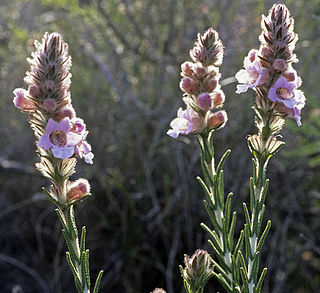
Hemiphora bartlingii, commonly known as woolly dragon, is a flowering plant in the mint family Lamiaceae and is endemic to the south-west of Western Australia. It is an erect shrub with branches covered with greyish, rusty-coloured hairs, leaves with a blistered appearance and with white, pink or purple flowers over an extended period.

Conospermum bracteosum is a species of flowering plant in the family Proteaceae and is endemic to the south-west of Western Australia. It is an erect, spindly shrub with egg-shaped leaves, sometimes with the narrower end towards the base, and spikes of silky, woolly, tube-shaped white flowers.

Boronia stricta is a plant in the citrus family, Rutaceae and is endemic to near-coastal areas of the south-west of Western Australia. It is a slender shrub with often crowded pinnate leaves with linear leaflets, and pink, four-petalled flowers borne singly or in groups of two or three in leaf axils.

Diplolaena microcephala is a rounded shrub with elliptic leaves, distinctive stamens, variable flower colour and is endemic to Western Australia.
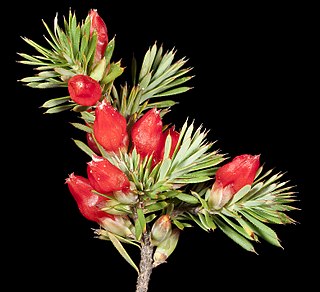
Styphelia tortifolia is a species of flowering plant in the heath family Ericaceae and is endemic to the south-west of Western Australia. It is a shrub with linear or narrowly oblong leaves, and red, tube-shaped flowers with bearded lobes.
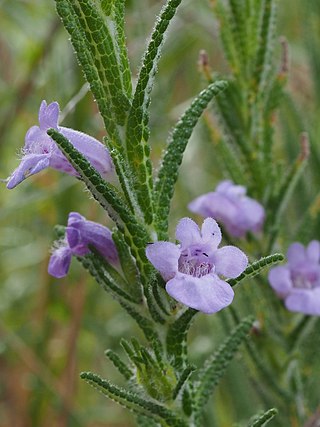
Chloanthes parviflora is a species of flowering plant in the family Lamiaceae. It is a small, rounded shrub with dark green, linear leaves and mauve tubular flowers. It grows in New South Wales and Queensland.

Eutaxia cuneata is a species of flowering plant in the family Fabaceae and is endemic to the south-west of Western Australia. It is a slender, upright shrub with red and orange pea-like flowers.
Olearia lehmanniana is a species of flowering plant in the family Asteraceae and is endemic to inland areas of the south-west of Western Australia. It is a shrub with scattered elliptic or linear leaves that are densely hairy on the lower surface, and pale mauve, daisy-like inflorescences.
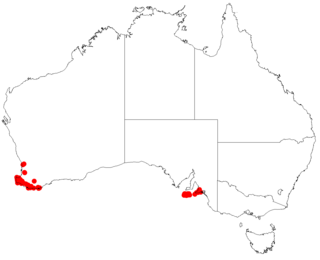
Leucopogon hirsutus is a species of flowering plant in the heath family Ericaceae and is endemic to southern continental Australia. It is a low-lying or straggling shrub with elliptic to oblong leaves and inconspicuous, white, bell-shaped flowers.

Thomasia cognata is a species of flowering plant in the family Malvaceae and is endemic to the south-west of Western Australia. It is a compact, multi-stemmed shrub with wrinkled, narrowly oblong to elliptic leaves and pale pink flowers.
Thomasia rulingioides is a species of flowering plant in the family Malvaceae and is endemic to the south-west of Western Australia. It is an erect, open shrub with densely hairy new growth, narrowly oblong to narrowly egg-shaped leaves with wavy edges, and pink to purple flowers.
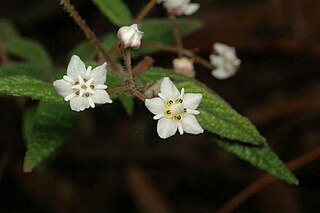
Commersonia rugosa is a species of flowering plant in the family Malvaceae and endemic to New South Wales. It is an open, straggly shrub with linear to narrowly egg-shaped leaves with irregular teeth or lobes on the edges, and white flowers in clusters of 3 to 15.

Leucopogon tetragonus is a species of flowering plant in the family Ericaceae, and is endemic to the south of Western Australia. It is a robust shrub with crowded, often decussate, oblong to lance-shaped leaves and short, dense spikes of white, tube-shaped flowers.



















